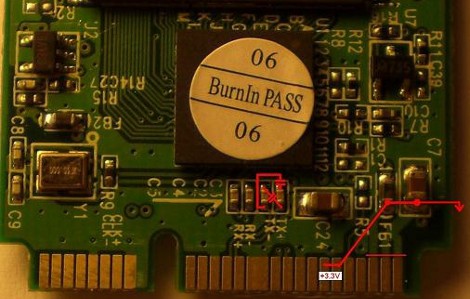[Trucki] wanted to upgrade the internal storage on his JooJoo. There’s an mSATA connector inside but devices that use that protocol are hard to come by and when you do they’ll cost you and arm and a leg. He knew he could get solid state drives cheaply that use the mini PCI Express standard, which is mechanically compatible with mSATA. So he set out to alter a mini PCI Express device to work with the mSATA protocol. This entails swapping the transmission lines and rearranging the voltage traces on the connector. To handle the TX- and TX+ lines he desoldered their decoupling capacitors and realigned them to trade their signals. For the 3.3V lines he had to cut the feed and solder jumper wire to the correct pads.
This is some nice work which let him add a 32 GB drive for just sixty Euros. Since the device only comes with a 4 GB SSD an upgrade is almost mandatory if you’re planning to install an alternate OS on the Joojoo.
















Niiice!
Super jump in storage and a very cool hack = WIN
This has NOTHING to do with mini PCI Express, he modded FLASHCON SSD to mSATA standard. Flashcon is something ASUS came up for EEE mini netbooks. Its SATA in mPCI connector, later more manufacturers agreed on a standard and called it mSATA.
@rasz:
So given that, I should be able to convert an mSATA board to work in my Eee? Hmmmmmmm…
I know the JooJoo hackers have been looking for ages for ways to upgrade their storage space on these things. Previously the only way to do it was to buy bulk drives from the JooJoo SSD manufacturers at extortinate prices.
So, huge props to @Trucki.
It’s just a shame the JooJoo’s not produced any more, the specs are pretty awsome compared to the competition, once you get rid of the stock OS, of course.
Could ya not do a guide on how to mod the joojoo to accept mini pci express devices? would that not provide a better comprehensive solution to the problem??
My god is the JooJoo expensive.
I remembered this idea posted long ago so I
wikied this and
read that it was that thing posted here and that this is the product of the stolen idea
I wouldn’t buy the thing
nice hack.
has anyone found out how to hack the 16GB drives in the AA1 to use as external storage?
i have yet to get mine working which is a shame as even though slow it is 16GB.
Impressive ‘I won’t be stopped because I’m smart’ attitude.
@zeropointmodule
There’s no need to hack them. They’re standard ZIF socket PATA drives. Same connector as the iPod hard drives, just with a thicker (Hitachi, IIRC) ribbon cable. The Aspire Ones, unlike the Eee’s, used standard components for their models. Have a 8GB model AAO, and yes, those SSDs are worthlessly slow. I rerouted one USB port to be internal and booted Linux using a SD/USB Card Reader. Was loads faster than the internal SSD.
Shame the left side SD slot isn’t bootable. Would have saved a lot of headaches.
Hello world! I’m looking for a way to install a mini pcie ssd to my hp dm1z-3000. There’s a free slot for that, but I can’t really tell if it’s a pcie or msata or are these two the same thing %)
Please view this topic
http://forum.notebookreview.com/hp-pavilion-notebooks/501683-hp-dm1z-271.html#post7484227
Any help ‘preciated!
Is it possible to do it the other way round – make an mSATA device work in a Mini-PCIe connector?
I have an mSATA SSD (OCZ Nocti 30GB) and want to install it on a board that has a Mini-PCIe slot, but doesn’t support mSATA.
Has anyone a working link of the dead forum, or the information posted there?
I have a spare Kingspec 64 Gb mSATA SSD and I think this hack could be usefull to install it on my Sony VAIO FE computer (whici also has a spare miniPCI-E connectort).
Thanks!!
Hello all!
I know this post is more than a year dead, but I would like to know if there is someone with a copy of the linked post. I’ve searched all around internet and Google is already laughing at me for asking it so much :-P.
The original link is dead and I think that this hack could be great to use a Kingspec 64 Gb mini PCI-E SSD I have on a mini PCI-E connector available in my Sony VAIO FE computer.
Thank you!
The Waybackmachine project is an awesome resource for dead websites/links.
Here is a link if you want to view the dead forum:
http://web.archive.org/web/20111223101448/http://www.thejoojooforum.com/viewtopic.php?f=4&t=776&p=4961
This is how the forum looked as at 23rd December 2011 when Waybackmachine crawler passed through the site.
Hope this helps. Share the love and keep these awesome projects alive.
If anyone knows how to do this please let us know, thank you
https://farm6.staticflickr.com/5156/6949952266_193e08892c_z.jpg
I think you need to change the polarization of the RX line